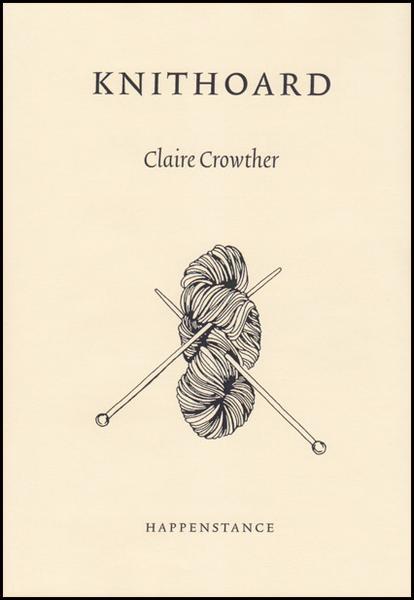
Miss Marple gave a tinkly little laugh.
‘You’re so severe – of course the weather is a very English subject of conversation – one forgets – Oh dear – this is the wrong coloured wool.’
[…]
‘Take me back inside,’ said Mr Rafiel. ‘I’ll have my massage now before that chattering hen comes back.’
Presenting herself as more foolish than she really was, merely an old lady wreathed in clouds of fluffy pink wool, was part of Miss Marple’s stock-in-trade. But the trope of the slightly dim, elderly, knitter is tenacious, and a source of frustration for anyone – young or old – who enjoys needle arts and takes pride in the skill and practice needed to learn them.
When I saw Claire Crowther’s pamphlet advertised I was certain – based on my respect for HappenStance Press, and my knowledge of Crowther’s skill as a poet (this is her ninth book) – that it wouldn’t contain twee little verses dragging out the same old cliches about grandmothers and cosy domesticity. I wasn’t disappointed.
I was laid under the lilac
being born in May.
All the pattern was in my body.
These poems are as skilfully constructed as any I have read, and the subject matter takes us far deeper than the knitted surface, exploring the joys and frustrations of acquiring a new skill, touching on loss, ageing, and connection with those close to us or perhaps only conjured in our imaginations.
The pamphlet is a sequence of 21 poems, with a narrative arc that sees our speaker beginning with making slow stitches, battling with tension and dropped needles, gradually making progress.
When the slippery needle slides out of its row
and falls silently
down from whosever precipice of lap
it lies on:
its stitches quiver and peer
out from behind each other
New voices enter occasionally. ‘Handmade’ is spoken from the perspective of a professional garment knitter: ‘I am quick but I have to be perfect. / Not one mistake / though mistakes are proofmarks of makers.’ The word ‘poet’ means maker, and this poem speaks to the truth of learning and making in any discipline – we are only human and mistakes are part of the process. For this knitter though, whose ‘knuckles are hard as stone and swollen’ and who has ‘scored each peerie stitch on my fingers’ there is no space for error. She knits rapidly on, imagining the anonymous wearer of the garment she’s creating.
‘Handmade’ is an example of how effortlessly Crowther uses tone and sound to change the mood of a poem. For example, in the opening poem:
All my pattern was in my body.
I opened my eyes to rough leaves
blowing apart and broken.
The lines are lyrical and moving, the new knitter is making progress, and is full of anticipation. Learning something new is a tricky beast though, turn the page and the language changes:
My terms are hard.
Cast
Cast off.
I’ve misheard
harsh sounds.
PSSO.
Steek.
The lines are short and the words are clipped. We can almost taste the frustration, and even if we’ve never tried to knit, we know what it’s like to not get something, to be confused by unfamiliar terms, to want it to just. be. easier. please.
Greater proficiency comes eventually though, and then the mind can wander while the stitches form. The later poems consider an approaching end: ‘I will finish abandoned garments, cast off all / those vests sleeping in bags and drawers’. ‘Old Lovers’ Paradox’ hints at regret: ‘Yet where two are / knit together, / the pattern says Dec. // You’re not, it says, / bound to increase.’ And the final poem of the pamphlet, referencing the Book of Revelation, is a resounding call: ‘Woman of the sun, unwind it now. / Lady of shine, shake out your rays. // I pray: / unlace me from my stitchery.’ The end of a period of obsession with a new activity, or the end of a life?
An unusual form is used throughout the sequence. Each poem opens with a couplet in italics, whose two lines form the first and last lines of the following poem. Some of the couplets have the ring of quotations, but I wasn’t able to turn up any sources and I’m sure they would have been attributed if they were. I find myself associating the form with an image of a folded sweater, in which the top and bottom edge are brought together, or perhaps the kind of colourwork sweater in which the pattern appears around the yoke and the hems, like this one. I like the way the form both makes each poem feel enclosed by itself, and also links the sequence into a whole.
These are not really poems about knitting, they are poems about life, and death, and learning, and the decisions we make as we progress from one to the other. Crowther explicitly includes and welcomes those who might not be familiar with knitting by placing her glossary of terms at the front of the collection instead of the back. ‘Please don’t think this book is not for you,’ it seems to say. I would give these poems to any number of my knitting friends, of course, but I would urge them on any other reader as well. This pamphlet is a wonderful accomplishment. Crowther was taken a topic that’s almost impossible to write about without sounding quaint or sentimental and made something astonishing.
Knithoard is published by HappenStance Press (2019).